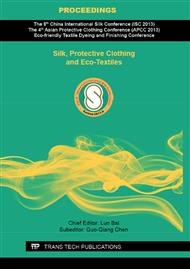p.3
p.9
p.15
p.21
p.25
p.36
p.39
p.43
Chain Conformational Study on Underwater Silk Proteins from Caddisfly, Stenopsyche marmorata - Implication of a Fiber-Forming Mechanism
Abstract:
Larval silk/cement proteins from a caddisfly, Stenopsyche marmorata, were isolated as a protein mixture of Smsp-1, 2, 3 and 4. Smsp-1 is a giant phosphorylated protein, which occupies ca. 45%-mass of the silk gland content, and composed of a long-range periodic amino acid sequences, involving 8 kinds of characteristic segments. The silk protein film was prepared and drawn in water up to 9-folds of the initial axis length, then the drawn film was subjected to polarized FT-IR and WAXD. The results implied that the Smsp-1 backbone adopts two different conformations, one of which was the β-turn-like conformers. The molecular mechanic studies were separately performed to evaluate the solid-state chain structures of the hydrophobic/Pro-rich segments 3 and 4, which are enriched in the primary sequence of Smsp-1, and the results were coincident with those from the vibration spectra and WAXD. The molecular dynamic (MD) studies were also carried out in order to estimate their preferred chain conformations in a solution state. The MD trajectory suggests that the segments 3 and 4 tend to adopt a turn-like conformation, which is a potential precursor of the β-turn-like conformers. In conclusion, the underwater silk proteins have a fiber-forming mechanism, which is substantially different from a silkworm, Bombyx mori.
Info:
Periodical:
Pages:
3-8
Citation:
Online since:
September 2013
Price:
Сopyright:
© 2013 Trans Tech Publications Ltd. All Rights Reserved
Share:
Citation:


